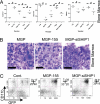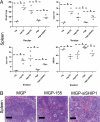Inositol phosphatase SHIP1 is a primary target of miR-155
- PMID: 19359473
- PMCID: PMC2678424
- DOI: 10.1073/pnas.0902636106
Inositol phosphatase SHIP1 is a primary target of miR-155
Abstract
MicroRNA-155 (miR-155) has emerged as a critical regulator of immune cell development, function, and disease. However, the mechanistic basis for its impact on the hematopoietic system remains largely unresolved. Because miRNAs function by repressing specific mRNAs through direct 3'UTR interactions, we have searched for targets of miR-155 implicated in the regulation of hematopoiesis. In the present study, we identify Src homology-2 domain-containing inositol 5-phosphatase 1 (SHIP1) as a direct target of miR-155, and, using gain and loss of function approaches, show that miR-155 represses SHIP1 through direct 3'UTR interactions that have been highly conserved throughout evolution. Repression of endogenous SHIP1 by miR-155 occurred following sustained over-expression of miR-155 in hematopoietic cells both in vitro and in vivo, and resulted in increased activation of the kinase Akt during the cellular response to LPS. Furthermore, SHIP1 was also repressed by physiologically regulated miR-155, which was observed in LPS-treated WT versus miR-155(-/-) primary macrophages. In mice, specific knockdown of SHIP1 in the hematopoietic system following retroviral delivery of a miR-155-formatted siRNA against SHIP1 resulted in a myeloproliferative disorder, with striking similarities to that observed in miR-155-expressing mice. Our study unveils a molecular link between miR-155 and SHIP1 and provides evidence that repression of SHIP1 is an important component of miR-155 biology.
Conflict of interest statement
Conflict of interest: D.B. is on the Board of Directors and Chairs the Scientific Advisory Board of Regulus Therapeutics, a microRNA company. R.M.O has consulted for Regulus Therapeutics.
Figures





References
-
- Baltimore D, Boldin MP, O'Connell RM, Rao DS, Taganov KD. MicroRNAs: new regulators of immune cell development and function. Nat Immunol. 2008;9:839–845. - PubMed
-
- Bartel DP, Chen CZ. Micromanagers of gene expression: the potentially widespread influence of metazoan microRNAs. Nat Rev Genet. 2004;5:396–400. - PubMed
-
- Lodish HF, Zhou B, Liu G, Chen CZ. Micromanagement of the immune system by microRNAs. Nat Rev Immunol. 2008;8:120–130. - PubMed
Publication types
MeSH terms
Substances
Grants and funding
LinkOut - more resources
Full Text Sources
Other Literature Sources
Molecular Biology Databases
Research Materials
Miscellaneous

